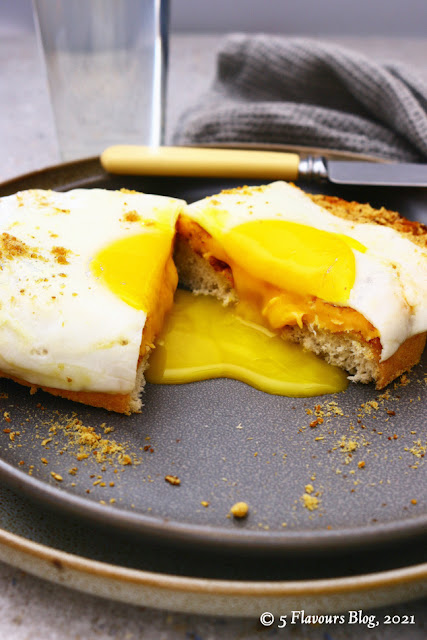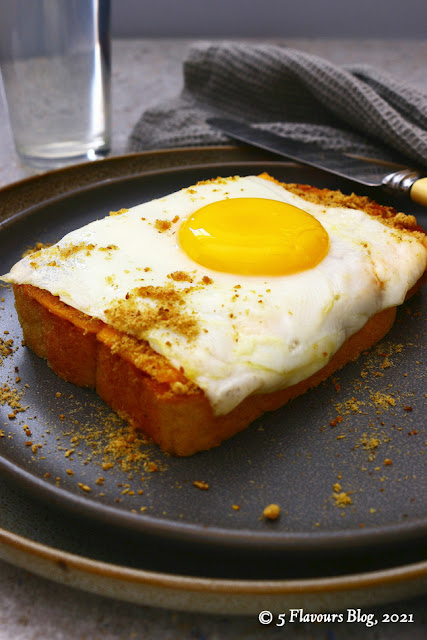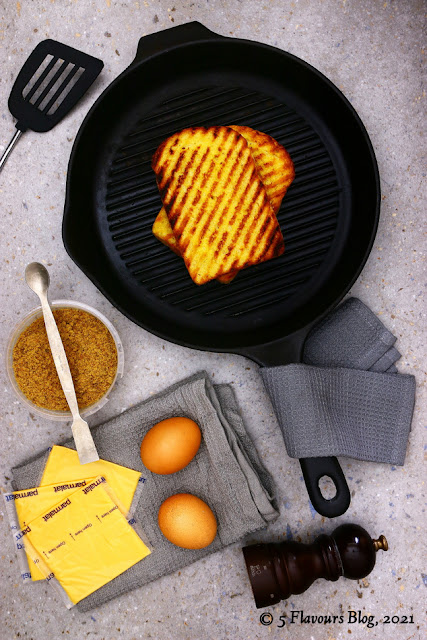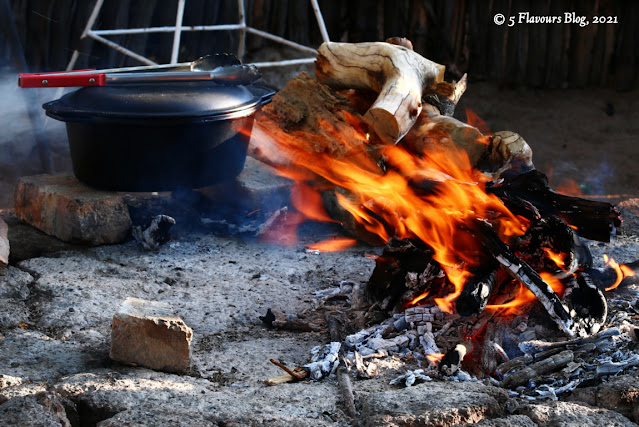Wooly Bully Fried Slice
–
Jump To Recipe –
–
Print Recipe –
Immutable pillars. We all know someone like that:
utterly dependable, reliable and steadfast. Nearly always readily approachable
and quite often solitary souls. Ever wondered where they turn to on those days
when their metaphorical sky overhead is the color of a television tuned to a
dead channel? For those steeped in the by now effortless comforts of well worn
solitude; the choices are limited.
The remedial solace of favorite
dishes for those days when the world revolts against us
in a thousand little ways were discussed in previous posts. Examples are 2 Cheese Curried Omelette, The Belfried Pig and Orange Syrup & Coconut Tart. Wooly Bully – or Soft Egg & Cheese – Fried Slice is a palliative that also
falls in this category, but on the far, acute end. To be called for on those shambling
days numb in the shadow of a darkened moon when ladders are few and steep.
The dish is fast and easy to prepare with basic
ingredients almost always at hand. Also, a significant benefit is the minimum
of dirty dishes generated during the preparation and eventual tucking in into
the sublimity of liquid sunshine, sultry molten cheese and the buttery comfort
of fried bread. Powdered biltong adds a swanky, wholesome undertone that
imperceptibly elevates the spirit and hastens the transit of any penumbra.
Conveniently, when prepared with fried eggs of a
firmer consistency, poached eggs, mushy scrambled eggs or even a folded
omelette, the dish still inspires and gladdens the anima.
Uno dos
One two tres quatro
Ay, wooly bully
Watch it now, watch it
Here he comes, here he
comes
Watch it now, he get ‘cha
Matty told Hatty
About a thing she saw
Had two big horns
And a wooly jaw
Wooly bully,
Wooly bully ...
Sam The Sham & The Pharaohs,
1965
SUNNY SIDE UP EGG & CHEESE FRIED SLICE
– PRINT RECIPE –
|
Recipe yields: 1 Portion |
Preparation time: ± 5 Minutes |
Cooking time: 7 – 10 Minutes |
Special Equipment Required:
1 x 25cm Heavy skillet with a fitting lid.
Ingredients:
|
White bread, thick sliced, well
buttered on each side |
2 |
|
X/L Eggs, fried sunny side
up |
2 |
|
Processed cheese slices |
6 |
|
Biltong powder / Powdered
beef jerky |
2 x 15ml |
|
Fine cayenne pepper |
± 1 ml |
|
Black pepper, freshly
ground |
To taste |
|
Salt |
To taste |
Method:
- Fry the buttered bread slices on one side in the covered skillet over medium high heat until the slices are browned to your degree of choice.
- Turn the bread and immediately add the cheese slices to the very hot, just turned sides of the bread slices. Cover and turn the heat down to medium. Fry until the cheese on top is molten and gooey.
- Simultaneously, in a separate pan-fry your eggs sunny side up (or in any other favourite form) to your preferred degree of doneness. Attempt to have the molten cheese on the fried bread and the eggs ready simultaneously.
- Remove the fried bread slices to a pre-warmed plate and immediately sprinkle the cayenne pepper and powdered biltong (or beef jerky) over. Quickly add the eggs on top of each slice.
- Season to taste with salt and freshly ground black pepper.
- Serve immediately with a mug of your favorite Ceylon tea – hot, milky and sweet.
Comments:
- Try to use the most expensive processed cheese you can find? Generally, I don’t favour processed cheese, but for the state of mind this recipe is intended for, good processed cheese is acceptable and we’ll let the temporary lapse in culinary standards slide.
- Having your molten cheese topped bread slices and fried eggs ready simultaneously requires a modicum of hand & eye coordination. Fortunately practice makes perfect and even the ‘failures’ go down with gusto and alacrity.
- For a more substantial meal, add hefty scoops of best quality tinned baked beans as a side dish. Mix a dollop of good quality balsamic vinegar into the baked beans for a spirit lifting adventure.
BILTONG
Biltong – a type of cured, air dried meat – is a
uniquely quaint South African delicacy that started out long ago as a very
important and common meat preservation technique to conserve excess quantities
of beef and game in a durable, readily consumable format. During our South
African frontier days the ability to make biltong was an essential and life
preserving skill. Each family had their own recipe, favoured meat cuts and
techniques, and not being able to make biltong seriously dented any prospective
bride’s eligibility for marriage.
Somewhat later on, during the ‘taming’ of the vast
Southern African wilderness, producing biltong in bulk from game became an
essential process, and often lucrative career, to supply animal protein as a
durable, readily produced and easy to transport commodity to many labour
intensive industries. Commercial activities that included mines and railroad construction
companies as well as large scale agricultural endeavours such as sugar cane,
coffee and tea plantations as well as commercial cattle ranches. Thousands of labourers
had to be fed daily (and cost effectively) to achieve maximum productivity for
their capitalist overlords. Biltong was a cheap and readily derived from the
vast herds of African plains game. The hunting journals of many famous big game
hunters from that era abound with stories of narrow scrapes with African
buffalo (and often elephant and hippo as well) shot for their meat, hides and
ivory as an extra income when no rich European aristocrats or foreign
Industrialists were around as guided, paying clients for safaris often lasting
several months.
The arrival of effective and cheap electrical refrigeration
liberated the average housewife and household supervisor from the cumbersome chore
of frequently preparing biltong. Today, it is almost exclusively a male
prerogative with many non-commercial hunters preparing biltong as a hobby from
sport hunted venison (less frequently farm raised beef). Invariably this
biltong is a delicacy produced for personal consumption according to each
Nimrod’s often closely guarded recipe and technique. And infallibly, where two
or more of these weekend Nimrods would gather in their man caves, at least one
would own – and have present – a custom made pocket knife with a sheep’s foot
blade profile dedicated to only, and only, cut its proud owner’s biltong.
Beef biltong, however, is a huge commercial activity in
South Africa today. It is exceedingly rare to find any butchery not making
their own to varying degrees of success and popularity, from sole
proprietorships right up to the in-house butchery sections of the big chain grocers.
Traditionally, the main ingredients of biltong are meat,
ground black pepper, lightly roasted & crushed coriander seed, salt, spirit
vinegar and Worcestershire sauce, often with varying quantities of brown sugar.
Additional, modern flavourings and seasonings include – amongst others – balsamic
vinegar (sometimes with malt or cider vinegars also), ground allspice, dried
& ground chillies, nutmeg and less frequently saltpeter or sodium nitrite.
The preparation methods vary wildly, but generally include as standard steps
marinating in vinegar solution wide strips of meat cut from several standard
carcass sections, followed by flavouring and curing the drained strips and
finally drying the cured, flavoured meat by means of various methods from plain
old air drying through assorted home built contraptions up to sophisticated,
commercially produced mechanical dryers with impressive temperature, humidity
and air flow controls.
Being unfamiliar with American jerky (or Mexican carne
seca for that matter), I have to rely on external sources describing the
differences between biltong and jerky. Wikipedia says:
“Biltong differs from
jerky in three distinct ways:
- The meat used in biltong can be much thicker due to the slower drying time in dry air conditions; typically biltong meat is cut in strips approximately 1"(25 mm) wide – but can be thicker. Jerky is normally very thin meat.
- The vinegar, salt and spices in biltong, together with the drying process cure the meat as well as adding texture and flavour. Jerky is traditionally dried with salt but without vinegar.
- Jerky is often smoked; biltong is rarely smoked.”
Sliced biltong (and its usually associated droë wors – sections of thin, air dried
beef sausage) is a popular snack at informal South African braais (back yard barbeques), is frequently found as a light
appetizer in many of our higher end restaurants and quite often encountered at
fancy event functions as a light amuse
bouché. It is absolutely mandatory as a savoury snack on long road trips
irrespective whether said trips be for leisure, sport or business. And off
course, no televised South African rugby match is a real match without biltong
or droë wors present, irrespective
whether you are by yourself or in the raucous company of soon to be inebriated
friends.
Sliced – and sometimes diced up – biltong are also
popular additions to stews, soups, muffins or an assortment of quick risen
savoury breads such as cheese & herb. Some enterprising home bakers like to
add it to pot bread – butter enriched,
yeast risen white bread prepared in a round, flat bottomed cast iron pot and
baked in embers and coals on the side of an open barbeque fire. Commercially,
we have a quite a range of biltong flavoured or enriched foodstuffs available
varying from biltong flavoured chips (crisps for you linguistically heathen
Americans) through various baked goods up to and including cheese spreads of
varying shades of dreadfulness.
Fairly recently, biltong and blue cheese soup was a
popular culinary Cinderella trying to find her hare-brained, not so royal prince.
Depending on the cook or chef involved, the soup could vary from truly sublime
right down to the abominable. Thankfully its popularity waned at last. Sadly
still popular are an assortment of biltong and [… insert your animal of choice
here …] potjies. Now a potjie as a cooking utensil is a very
popular, three legged cast iron pot of standard sizes and is used to cook an assortment
of dishes over an open fire. Favoured dishes are a variety of stews, mielie pap (maize porridge) and steamed breads. Potjie or potjie kos
invariably refers to a hodge-podge stew of some sort of meat, a motley
collection of vegetables, a starch of some sort, a gravy of widely varying consistency
and sometimes savoury dumplings steamed on top of the stew as it cooks. As with
biltong and blue cheese soup, the quality of the final potjie can vary from rather good to almost inedible depending on
the experience, ability and levels of intoxication of the almost universally
male cooks. In my opinion, biltong is a wasted and misused addition to any potjie.
And finally but not least: small biltong strips are often
used as a teething aid for babies. The drier the biltong is, the better it
becomes for itchy gums. I must make a mental note of this as my return to
toothlessness started recently too.
© RS Young, 2021
Sources:
1. BILTONG;
https://en.wikipedia.org/wiki/Biltong; Retrieved on 24/01/2021.
– RECIPE INDEX PAGE –
Follow Me on Facebook
Note:
Post updated on 2025.01.21 to include:
1.
The updated Recipe for downloading as a PDF file, and
2.
Recipe Title and Print Recipe, Recipe Index and Facebook & Pinterest follow
links.









Comments
Post a Comment